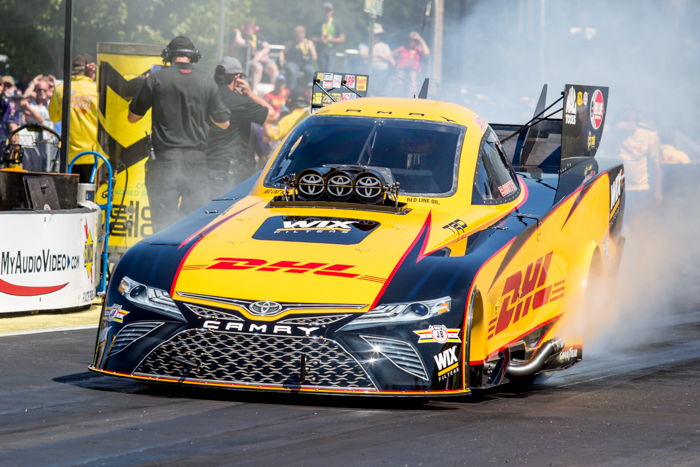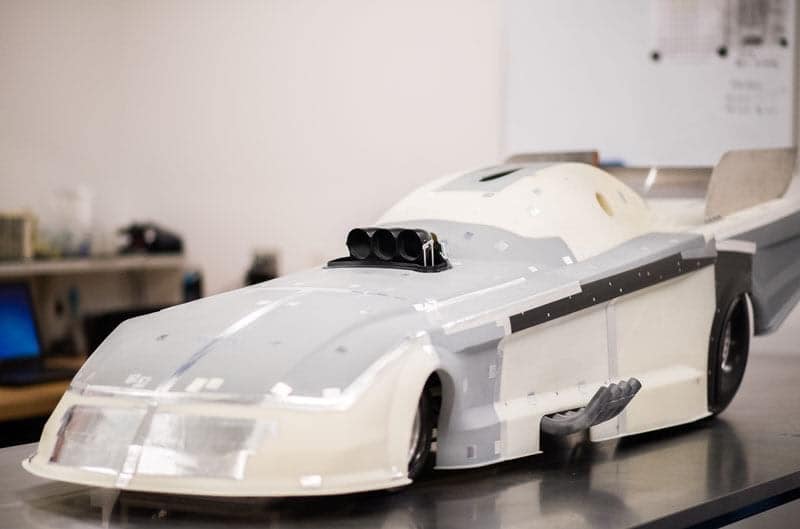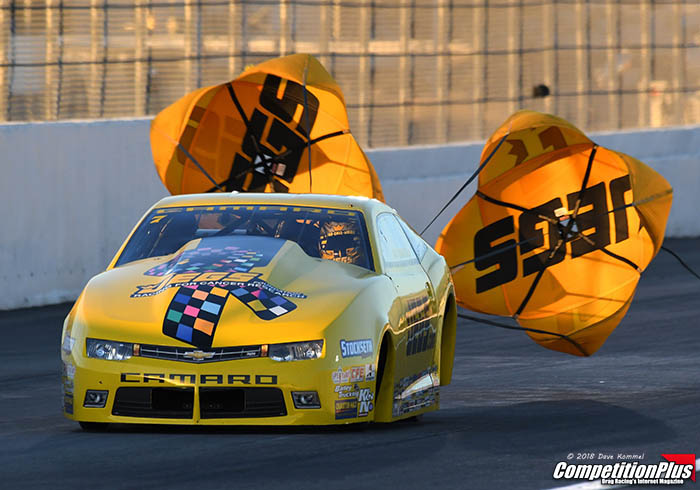FUNNY CAR BORROWS PAGE FROM PRO STOCK HISTORY


Drag-racing fans aren’t likely to see a Bill Doner-stoked phenomenon called “64 Pro Stock Cars.”
That’s a Funny Car classic.
But fans also aren’t likely to see the big, smoky Funny Car burnouts à la Jungle Jim Liberman or Pat Minick or a younger John Force.
That’s a practice the NHRA has tried to use to revive a struggling Pro Stock class (although it might not have been struggling so much if the sanctioning body hadn’t started messing with it).
Central to the Pro Stock’s legacy is a reputation for keen rivalries among the Big Three automakers and some of the most colorful competitors in class history. But Jason Line said that is simply a memory.
“I don’t think you’re ever going to see that. Those days are come and gone,” the three-time Pro Stock champion said. “But things change, and you’ve got to figure out how to change with it and do it the right way. How that is I’m not sure. I don’t have all the answers. Nothing lasts forever. So you have to figure out how to roll with the punches and change, as well.”
More by evolution than any deliberate attempt to stay relevant, the Funny Car division has begun to pick up where the Pro Stock class left off. It is starting to see more participation from not only Chevrolet, Chrysler/Dodge, and Ford but also from Toyota.
So, have the Funny Car and Pro Stock classes traded trademarks? No, that hasn’t happened . . . not exactly. But a look back at the 2018 Countdown shows a fresh manufacturer diversity in the Funny Car class that traditionally has been associated with the doorslammer pros.
This year’s Funny Car championship narrowed to a race between a Toyota driver (JR Todd) and a Chevy driver (Robert Hight), with a Dodge loyalist (Ron Capps) and a Ford campaigner (Tim Wilkerson) in the top four. In the end, the top five – with Tommy Johnson Jr. sneaking in at No. 3 – were (in order) Toyota, Chevrolet, Dodge, Dodge, and Ford.
By contrast, the Pro Stock class – at least for the last few events of the 2018 season – was an all-Chevy parade except for Alan Prusinesky and his Dodge Dart. That’s in a class whose first race, in 1970, featured eight Chrysler entries, five Chevrolet Camaros, and three Ford Mavericks. Ford – which once trumpeted Dyno Don Nicholson, the Wayne Gapp/Jack Roush tandem, and the iconic Bob Glidden with his 85 victories and 10 championships – has no presence today in the category.

But Ford Motor Company evidently has valued the stacks of data that Bob Tasca III waved in front of its executives’ faces ever since it left John Force Racing and the Funny Car class at the close of the 2014 NHRA season. Tasca, a third-generation Blue Oval dealer, has served on a Ford product advisory board for 20 years, like his grandfather and father before him. Ford would be hard-pressed to find a more devoted disciple and brand ambassador. Even so, Tasca wasn’t afraid four years ago to speak out and tell The Powers That Be at the Dearborn, Mich., headquarters that they were making a mistake and missing a prime marketing opportunity by pulling out of the sport.
The decision-makers there at Ford saw his point. His badgering might not have been the sole reason Ford is returning. But it is doing so in a bigger way.
Tasca said his contacts at Ford had a measured reaction at first to his arguments. He said their fundamental comments were along the lines of “We like it. We get it. But how are you going to win? That’s the only reason we race, ultimately.”
At the recent SEMA Show at Las Vegas, Ford offered a sneak peek at the new Mustang Funny Car body it has developed since October 2017.
Longtime Ford Performance aerodynamicist Bernie Marcus said, “Design begins with the use of computational fluid dynamics, which then turns into building parts to wind-tunnel test on a scale model of the car. Once all those parts are verified, we produce a full-size model.”
So this cost-cutting process – the same that Ford has used for its previous race cars, including the Le Mans-winning Ford GT – represents a “breakthrough” for the automaker, according to Mark Rushbrook, global director for Ford Performance Motorsports.
That certainly sounds like Ford is incorporating drag racing into its motorsports package and increasing its footprint.
Toyota certain has done so – and reaped championship benefits with Kalitta Motorsports’ Camry-driving JR Todd. And Toyota reached over to NASCAR to step up its drag-racing R&D.
Bringing his 33-year NASCAR crew-chief expertise to Toyota Racing Development as a technical consultant is Slugger Labbe. He has worked with Terry Labonte, Kenny Irwin Jr., Michael Waltrip, Jeremy Mayfield, Dale Jarrett, Sterling Marlin, Jacques Villeneuve, Scott Speed, David Gilliland, Paul Menard, and Austin Dillon in stints at Yates Racing, Dale Earnhardt, Inc., Richard Petty Motorsports, Richard Childress Racing, and elsewhere. Labbe also has been in the TV booth as NASCAR analyst for NBC.
He said his Top Fuel buddies Hot Rod Fuller and Rob Flynn got him hooked on drag racing. Today at TRD, that’s his focus, along with working with the NASCAR Camping World Truck Series.
“I support the teams, providing them with anything they may need in terms of database programs and anything we can do - improve the parts and pieces, improve the chassis,” Labbe said. “With the teams racing, seemingly, every week, we try to do some things for them in research and development. We do a lot of measuring of the tracks and conditions we race in. I’m looking months down the road, while the teams are racing day to day. So when they do have the opportunity to test, we’ll have parts and pieces ready for them to test. It’s a neat job.

“Andy Graves at TRD [which usually brings four representatives to each NHRA race] called and asked me if I’d be interested in taking over this account for TRD and supporting the Toyota drag-racing program with different innovations and different thoughts,” he said. “I try to bring some of the NASCAR mentality that I’ve been used to for the last 33 years, as well as bring some of the technology and mindset over to the NHRA.
“We’ve done a lot of cool things with our NHRA teams to try to get better and put even more speed into the race cars. The Funny Car side has been really fun,” Labbe said.
Toward the end of last season, he said the Kalitta Motorsports team built me a Funny Car to bring to the TRD office in North Carolina. So now I can take engineers out and show them different parts and pieces. We get to show them what we’re working on and what we’re looking to work on for future development. Things like that are really cool. We’re buying into what the teams are doing, and they’re buying into what we’re doing. We’re just trying to get them to Victory Circle as fast as we can.”
He helped get Todd to the champions podium last November.
General Motors has a strong presence in Pro Stock and a huge one in the increasingly popular Factory Stock Showdown class with its Copo Camaro, but its limited presence in Funny Car is tied exclusively to the class’ biggest team, John Force Racing. (Sporadically, part-time racers will compete with older Chevy-model bodies, but the factory support goes to JFR.)
Judy Kouba Dominick, Chevrolet Racing’s trackside communications representative, said having JFR’s trio of Camaros – with Force, Robert Hight, and Courtney Force driving –
“We are fortunate enough to be partnered with John Force Racing. Even if you don’t know drag racing, you do know John Force,” she said.
“The NHRA offers Chevrolet an incredible opportunity to meet our fans on a grassroots level. It’s very open, very friendly. And they welcome the participation of the manufacturer. Every year NHRA gives the manufacturers a little bit more opportunity to bring some individuality to the bodies. The bodies still have to fit the template and they still have to meet all the safety requirements. But through decals and some shaping, we are able to make ours look very similar to a Camaro. The other manufacturers have that same option.”

And realizing that fans want cars to be relatable, to look like what they can get on the showroom floor at their local dealerships, is key to generating a buzz in any class. Decreasing ability to identify with a manufacturer or model is what has hurt the Pro Stock class – a category with plenty of personality and talent and extremely close, competitive on-track performance.
Dominick said GM isn’t choosing between Funny Car and Pro Stock – or Factory Stock Showdown, for that matter. It wants to be part of it all. But it’s clear GM wants that Funny Car “prime real estate,” as execs at Just Marketing have called John Force Racing.
“I do know that we have some longtime partnerships in Pro Stock and I don’t see that currently changing on any level. But Chevrolet has a great commitment to NHRA,” Dominick said. “We will try to work with them to make the sport even better. But you see the trajectory of NHRA just continue to go up. It’s a constant rise. It’s not a ‘blown-out-of-the-cannon and then how do you sustain that?’ They continue to build it, and they build it at a rate that’s consumable – for them to manage, for all of their partners to manage, for the teams to manage, and encourages more and more fans to come and watch.”
Steve Beahm, head of parts and service (Mopar) and passenger-car brands (including Dodge) for Fiat Chrysler Automobiles (FCA), saw the trend in Pro Stock.
“That’s a little bit why we got out of Pro Stock. We were in that class a long time,” he said.
And Beahm isn’t just shaping his manufacturer’s policy from an office in Auburn Hills, Mich. He was a bracket racer for 20 years and understands the sport from the bottom up. He simply sees the crowd’s shiny-new-toy, “I can buy something like that!” reaction to the Factory Stock Showdown class and to the stable, ever-alluring Funny Car class.
“We thought this was the right path. We think we’re on the right kind of class,” he said, energized about the rising popularity of the SAM Tech Factory Stock Showdown class that in November crowned Drag Pak Challenger driver Leah Pritchett its champion.

“That’s a little bit why we got out of Pro Stock. We were in that class a long time,” he said.
And Beahm isn’t just shaping his manufacturer’s policy from an office in Auburn Hills, Mich. He was a bracket racer for 20 years and understands the sport from the bottom up. He simply sees the crowd’s shiny-new-toy, “I can buy something like that!” reaction to the Factory Stock Showdown class and to the stable, ever-alluring Funny Car class.
“We thought this was the right path. We think we’re on the right kind of class,” he said, energized about the rising popularity of the SAM Tech Factory Stock Showdown class that in November crowned Drag Pak Challenger driver Leah Pritchett its champion.
“Right now, our commitment is on the Factory Stock Showdown. The classes are close enough in my point of view that I would hate not to have a championship-caliber [opportunity], trying to split my resources [with] Pro Stock. But we would be interested in looking at it. The NHRA has talked with us. We understand what they want. We’re trying to talk to our fans and make the best investment we can, because we have limited resources. So we’ll put it in places we feel like we’re going to get the most return.”
The certainly includes the Funny Car class. As for Pro Stock, Beahm said, “I think that class is going to grow, and you’re probably going to see some of the other classes maybe shrink.”
But Funny Car is strong, especially for his brand, with the Mopar Dodge Charger SRT Hellcat Funny Car debuting body this past year for Jack Beckman and Matt Hagan to drive for Don Schumacher Racing.
Teaming with the NHRA’s largest outfit, DSR, has been a coup for the Dodge and Mopar brands that have earned a total of four championships. The full four-driver Funny Car complement for Dodge-Mopar includes Ron Capps and Tommy Johnson Jr. In Beahm’s tenure, FCA also has Dodge Challenger R/T Scat Pack 1320 production car that’s geared for both the street and the dragstrip, for grassroots racers. Moreover, the Dodge brand has sponsored key races at Denver and Reading, Pa.
Toyota, which recently opened its state-of-the-art North American headquarters at Plano, Texas, is elbowing its way into the Funny Car mix, challenging the domestic manufacturers. And that signals a significant shift among the NHRA’s pro classes.
Get the @competitionplus Mobile APP to get your drag racing news quick and easy. - https://t.co/HsiKEmdZXO pic.twitter.com/qpgtrHqnpr
— Competition Plus (@competitionplus) January 4, 2019





































